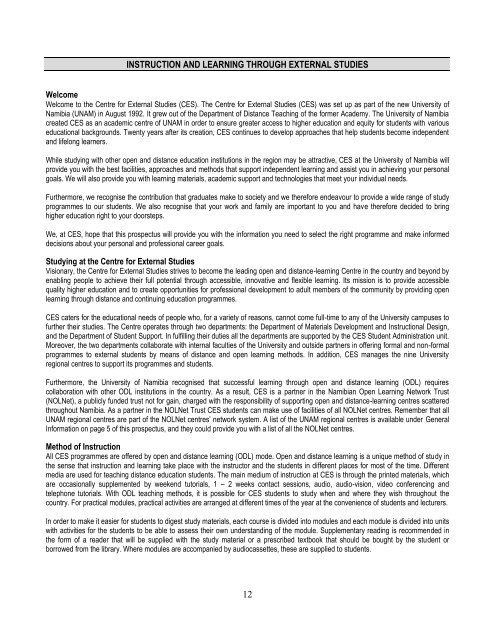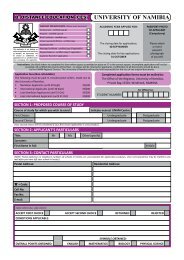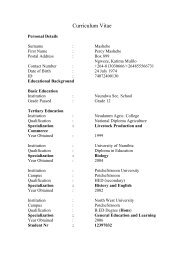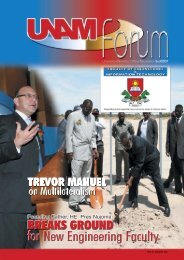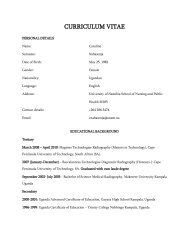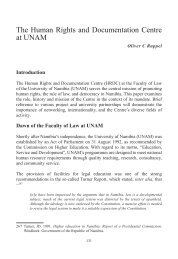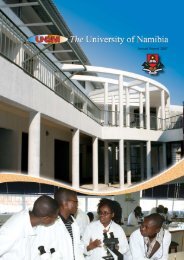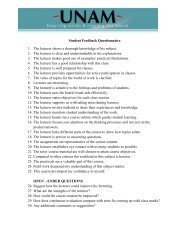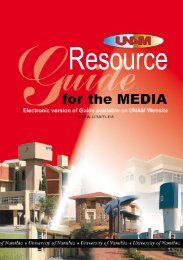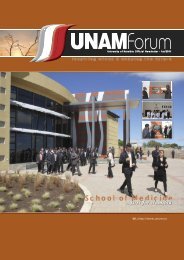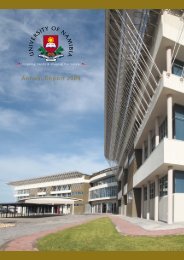UNIVERSITY OF NAMIBIA CENTRE FOR EXTERNAL STUDIES ...
UNIVERSITY OF NAMIBIA CENTRE FOR EXTERNAL STUDIES ...
UNIVERSITY OF NAMIBIA CENTRE FOR EXTERNAL STUDIES ...
You also want an ePaper? Increase the reach of your titles
YUMPU automatically turns print PDFs into web optimized ePapers that Google loves.
INSTRUCTION AND LEARNING THROUGH <strong>EXTERNAL</strong> <strong>STUDIES</strong>WelcomeWelcome to the Centre for External Studies (CES). The Centre for External Studies (CES) was set up as part of the new University ofNamibia (UNAM) in August 1992. It grew out of the Department of Distance Teaching of the former Academy. The University of Namibiacreated CES as an academic centre of UNAM in order to ensure greater access to higher education and equity for students with variouseducational backgrounds. Twenty years after its creation, CES continues to develop approaches that help students become independentand lifelong learners.While studying with other open and distance education institutions in the region may be attractive, CES at the University of Namibia willprovide you with the best facilities, approaches and methods that support independent learning and assist you in achieving your personalgoals. We will also provide you with learning materials, academic support and technologies that meet your individual needs.Furthermore, we recognise the contribution that graduates make to society and we therefore endeavour to provide a wide range of studyprogrammes to our students. We also recognise that your work and family are important to you and have therefore decided to bringhigher education right to your doorsteps.We, at CES, hope that this prospectus will provide you with the information you need to select the right programme and make informeddecisions about your personal and professional career goals.Studying at the Centre for External StudiesVisionary, the Centre for External Studies strives to become the leading open and distance-learning Centre in the country and beyond byenabling people to achieve their full potential through accessible, innovative and flexible learning. Its mission is to provide accessiblequality higher education and to create opportunities for professional development to adult members of the community by providing openlearning through distance and continuing education programmes.CES caters for the educational needs of people who, for a variety of reasons, cannot come full-time to any of the University campuses tofurther their studies. The Centre operates through two departments: the Department of Materials Development and Instructional Design,and the Department of Student Support. In fulfilling their duties all the departments are supported by the CES Student Administration unit.Moreover, the two departments collaborate with internal faculties of the University and outside partners in offering formal and non-formalprogrammes to external students by means of distance and open learning methods. In addition, CES manages the nine Universityregional centres to support its programmes and students.Furthermore, the University of Namibia recognised that successful learning through open and distance learning (ODL) requirescollaboration with other ODL institutions in the country. As a result, CES is a partner in the Namibian Open Learning Network Trust(NOLNet), a publicly funded trust not for gain, charged with the responsibility of supporting open and distance-learning centres scatteredthroughout Namibia. As a partner in the NOLNet Trust CES students can make use of facilities of all NOLNet centres. Remember that allUNAM regional centres are part of the NOLNet centres’ network system. A list of the UNAM regional centres is available under GeneralInformation on page 5 of this prospectus, and they could provide you with a list of all the NOLNet centres.Method of InstructionAll CES programmes are offered by open and distance learning (ODL) mode. Open and distance learning is a unique method of study inthe sense that instruction and learning take place with the instructor and the students in different places for most of the time. Differentmedia are used for teaching distance education students. The main medium of instruction at CES is through the printed materials, whichare occasionally supplemented by weekend tutorials, 1 – 2 weeks contact sessions, audio, audio-vision, video conferencing andtelephone tutorials. With ODL teaching methods, it is possible for CES students to study when and where they wish throughout thecountry. For practical modules, practical activities are arranged at different times of the year at the convenience of students and lecturers.In order to make it easier for students to digest study materials, each course is divided into modules and each module is divided into unitswith activities for the students to be able to assess their own understanding of the module. Supplementary reading is recommended inthe form of a reader that will be supplied with the study material or a prescribed textbook that should be bought by the student orborrowed from the library. Where modules are accompanied by audiocassettes, these are supplied to students.12


